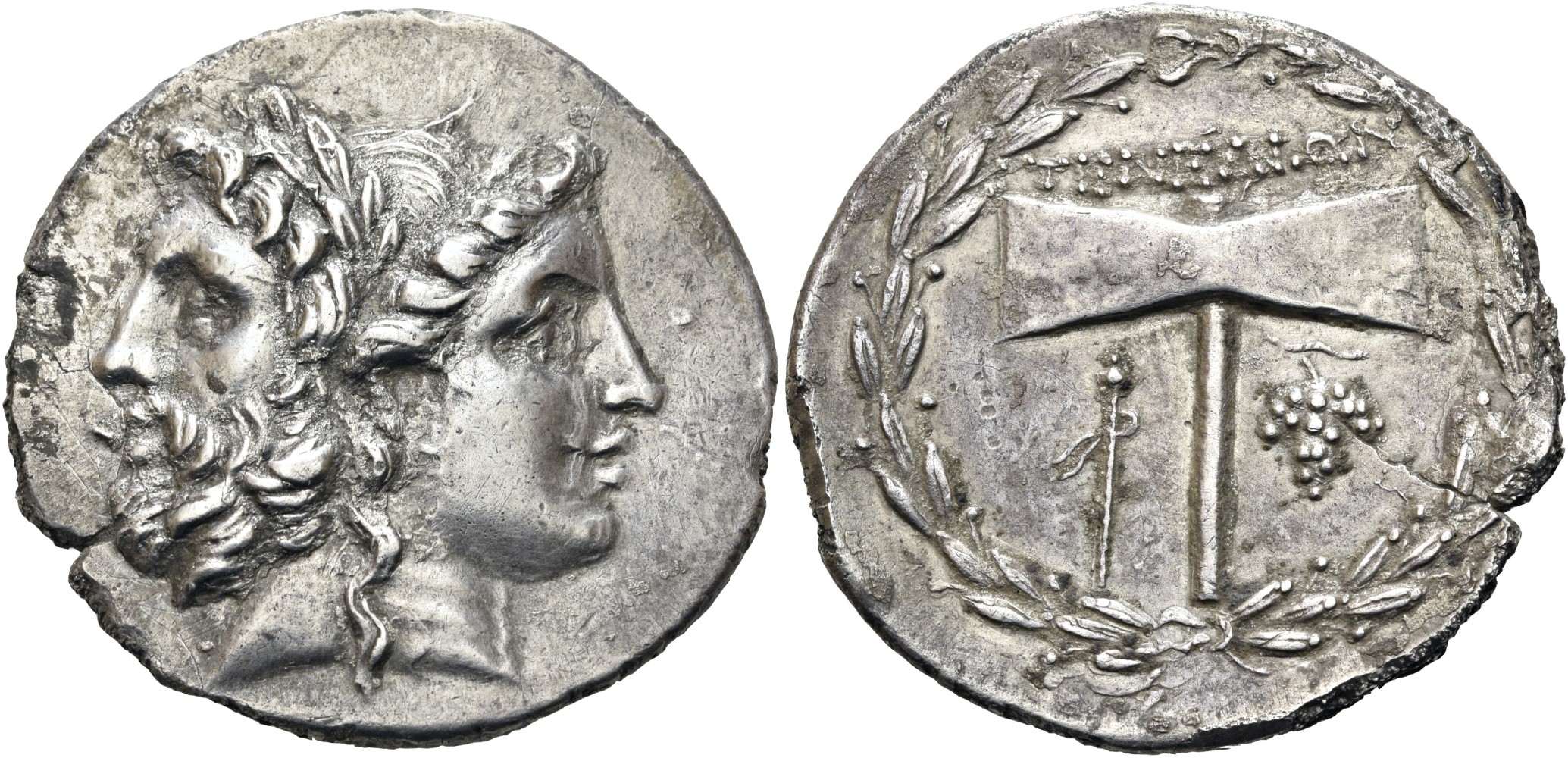Tenedos, silver, tetradrachms (100-70 BCE)
From SILVER
100 BCE - 70 BCE Silver 7,956 kg
Description
| ObverseInscription or printing placed on the obverse.: | Janiform head, male and bearded left, female and wearing a crown right. |
| ReverseInscription or printing placed on the reverse.: | TENEΔIΩN (Greek).Double axe. In the left field, bunch of grapes and monogram. In the right field, symbol (bunch of grapes, Dionysos, Artemis, palm, lyra, eagle, Athena, etc). All within a wreath. |
Mint and issuing power
| MintIdentifies the place of manufacture or issue of a numismatic object.: | Tenedos | Ancient regionAncient region.: | Troas | Modern countryModern country: Turkey | AuthorityIdentifies the issuing power. The authority can be "pretended" when the name or the portrait of X is on the coin but he/she was not the issuing power. It can also be "uncertain" when there is no mention of X on the coin but he/she was the issuing power according to the historical sources: |
Chronology
| FromIdentifies the initial date in a range assigned in a numismatic context. | 100 BCE | toIdentifies the final date in a range assigned in a numismatic context.. | 70 BCE | PeriodTime period of the numismatic object.: Hellenistic 323-30 BC |
Physical description
| MetalThe physical material (usually metal) from which an object is made.: | Silver |
Median weightMedian of the weights of numismatic objects (in grams). in grams | 16.35 | DenominationTerm indicating the value of a numismatic object. Examples: tetradrachm, chalkous, denarius.: | tetradrachm |
StandardStandard.: | Attic |
Image

RQEM ad. 322 - Tenedos, silver, tetradrachm, 90-70 BC.jpg [1]
References
| Die study referencePublication of the study: | Callataÿ 19981Callataÿ 1998 | ||
| Coin series referenceReference to coin series study: | Sear II2Sear II, n° 4157, HGC 63HGC 6, n° 390 | ||
Obverse dies distribution
| FrequencyFrequency of specimen in distribution. ᵖ | Number of obversesNumber of obverse dies. ᵖ (o) | % (o) | Number of coinsNumber of coins. (n) | % (n) | Die nameName(s) of the die(s). |
| 1 | 8 | 38.1 | 8 | 9.3 | 1, 2, 4, 5, 10, 12, 15, 16 |
| 2 | 2 | 9.52 | 4 | 4.65 | 6, 8 |
| 3 | 2 | 9.52 | 6 | 6.98 | 7, 17 |
| 4 | 3 | 14.29 | 12 | 13.95 | 3, 14, 19 |
| 6 | 1 | 4.76 | 6 | 6.98 | 21 |
| 7 | 1 | 4.76 | 7 | 8.14 | 18 |
| 8 | 2 | 9.52 | 16 | 18.6 | 9, 11 |
| 11 | 1 | 4.76 | 11 | 12.79 | 20 |
| 16 | 1 | 4.76 | 16 | 18.6 | 13 |
| Total | 21 of 21 | 99.99 | 86 of 86 | 99.99 |
Reverse dies distribution
no distribution is available
Quantification
| Number of obversesNumber of obverse dies. ᵖ (o) | 21 | Number of singletons (o1)The number of singleton coins. ᵖ | 8 |
| Number of reverse diesNumber of reverse dies. (r) | 75 | Number of coinsNumber of coins. (n) | 86 |
| Coins per obverse dieNumber of coins per obverse die. (n/o) | 4.1 | Coins per reverse dieNumber of coins per reverse die. (n/r) | 1.15 |
| Reverse per obverse ratioRatio of obverse dies divided by reverse dies. (r/o) | 3.57 | Percentage of singletons (o1)number of coins (n) divided by the number of singletons (o1) ᵖ | 38.1 % |
| Original number of dies (O) (Carter 1983 formula)The estimation of the number of coins according to Carter 1983 ᵖ | 24.33 | Coins struck if 20,000 as average productivity per dieCoins made if the average productivity for obverses (according to Carter) is 20,000. ᵖ | 486,600 |
| Original number of dies (O) (Esty 2011 formula)The estimation of the number of coins according to the singleton formula in Esty 2011 ᵖ (O) | 27.78 | Survival rate if 20,000 as average productivity per dieSurvival rate if average productivity is 20,000. ᵖ | 0.00018 |
| Coverage (o = % of O) (Esty 1984 formula)Esty 1984 - coverage (% of O) ᵖ (o = % of O) | 90.7% | Die productivity if survival rate 1/2,000Average productivity if survival rate is 1/2,000. ᵖ | 7,069.46 |
| Weight of silver (in kg) if 20,000 coins per die (O = Carter formula)Carter 1983 * Median weight * 20000 (*10 if gold or electrum) ᵖ | 7,956 kg <br /> 7,956 kg | Die productivity if survival rate 1/5,000Average productivity if survival rate is 1/5,000. ᵖ | 17,673.65 |
Remarks
Most likely one single workstation Likely military
References
- ^ Callataÿ, François de (1998), "Les monnaies hellénistiques en argent de Ténédos", in Georges Le Rider and Roger Bland (eds.), Studies in Greek Numismatics in memory of Martin Jessop Price, London, p. 99-114, pl. 24-28.
- ^ Sear, David R. (1979), Greek coins and their values. Vol. II, Asia and North Africa, London, xlviii, p. 317-762
- ^ Hoover, Oliver D. (2010), The Handbook of Greek Coinage Series, volume 6 : handbook of coins of the islands: Adriatic, Iionian, Thracian, Aegean, and Carpathian seas (excluding Crete and Cyprus), sixth to first centuries BC, Lancaster, 358 p.